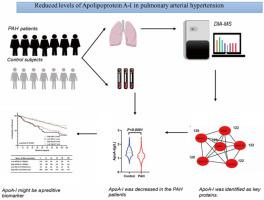Hellenic Journal of Cardiology ( IF 4.1 ) Pub Date : 2023-11-07 , DOI: 10.1016/j.hjc.2023.10.004 Yuxia Huang 1 , Ji Zhang 2 , Qinhua Zhao 1 , Xiaoyi Hu 1 , Hui Zhao 3 , Shang Wang 1 , Lan Wang 1 , Rong Jiang 1 , Wenhui Wu 1 , Jinming Liu 1 , Ping Yuan 1 , Sugang Gong 1

|
Background
The significance of apolipoprotein A-I (ApoA-I) is the anti-inflammatory functional component of high-density lipoprotein, which needs to be further studied in relation to pulmonary arterial hypertension (PAH). This study aimed to identify the predictive value of ApoA-1 on the risk and prognosis of PAH, as well as the underlying anti-inflammatory mechanism.
Methods
Proteomic analysis was conducted on lung tissue from 6 PAH patients and 4 lung donors. Prediction of risk and mortality risk factors associated with PAH in 343 patients used logistic analysis and Cox regression analysis, respectively. The protective function of ApoA-I was assessed in human pulmonary arterial endothelial cells (HPAEC), while its anti-inflammatory function was evaluated in THP-1 macrophages.
Results
In the lung tissues of patients with PAH, 168 differentially expressed proteins were associated with lipid metabolism according to GO and KEGG enrichment analysis. A protein-protein interaction network identified ApoA-I as a key protein associated with PAH. Lower ApoA-I levels were independent risk factors for PAH and displayed a stronger predictive value for PAH mortality. Plasma interleukin 6 (IL-6) levels were positively correlated with risk stratification and was higher in PAH patients with lower ApoA-I levels. ApoA-I was downregulated in lung tissues of MCT-induced rats. ApoA-I could reduce IL-6-induced pro-proliferative and pro-migratory abilities of HPAEC and inhibit secretion of IL-6 from macrophages, which is compromised under hypoxic conditions.
Conclusion
Our study identified the significance of ApoA-I as a biomarker for predicting the survival outcome of PAH patients, which might relate to its altered anti-inflammatory properties.
中文翻译:

载脂蛋白 AI 水平降低对肺动脉高压的影响
背景
载脂蛋白AI(ApoA-I)的意义是高密度脂蛋白的抗炎功能成分,其与肺动脉高压(PAH)的关系有待进一步研究。本研究旨在确定 ApoA-1 对 PAH 风险和预后的预测价值,以及潜在的抗炎机制。
方法
对 6 名 PAH 患者和 4 名肺捐献者的肺组织进行了蛋白质组学分析。分别使用逻辑分析和 Cox 回归分析预测 343 名患者与 PAH 相关的风险和死亡风险因素。在人肺动脉内皮细胞 (HPAEC) 中评估 ApoA-I 的保护功能,并在 THP-1 巨噬细胞中评估其抗炎功能。
结果
根据GO和KEGG富集分析,在PAH患者的肺组织中,有168个差异表达蛋白与脂质代谢相关。蛋白质-蛋白质相互作用网络将 ApoA-I 确定为与 PAH 相关的关键蛋白质。较低的 ApoA-I 水平是 PAH 的独立危险因素,对 PAH 死亡率具有更强的预测价值。血浆白细胞介素 6 (IL-6) 水平与风险分层呈正相关,并且在 ApoA-I 水平较低的 PAH 患者中血浆白细胞介素 6 (IL-6) 水平较高。MCT 诱导的大鼠肺组织中 ApoA-I 表达下调。ApoA-I 可以降低 IL-6 诱导的 HPAEC 的促增殖和促迁移能力,并抑制巨噬细胞分泌 IL-6,而巨噬细胞在缺氧条件下会受到损害。
结论
我们的研究确定了 ApoA-I 作为预测 PAH 患者生存结果的生物标志物的重要性,这可能与其抗炎特性的改变有关。



























 京公网安备 11010802027423号
京公网安备 11010802027423号